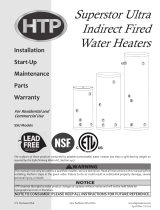
lp-83 Rev. 4.7.16
9
NOTE: It is possible to use live steam in the heat exchanger
of the SSU-80 and 119 residential and commercial models
ONLY. Using any other SSU model in live steam applications
will result in product failure and void the warranty.
C. Domestic Piping Inlet
Never use dielectric ttings or galvanized steel ttings on
any domestic water connections. Use only copper or brass
ttings. Failure to do so will result in premature water heater
failure. Such failure IS NOT covered by warranty.
Use both thread tape and pipe dope to connect an NPT brass
tee. On the run, install a brass drain valve. In the branch, install
an NPT male X 3/4” (minimum) pipe adapter. A shut-o valve
between the city water supply and tank inlet is recommended
for ease of service.
It may be recommended to use a back ow preventer - check
local codes. If a back ow preventer or a no return valve is
used, a thermal expansion tank must be installed on the
cold water supply between the tank and valve. If the tank is
replacing a tankless coil in the boiler, disconnect coil plumbing
and use the cold inlet pipe and hot water outlet pipes for the
water heater.
D. Temperature and Pressure Relief Valve
On SSU-80 and SSU-119 residential models, as well as all
commercial models, a 3/4” temperature and pressure (T&P)
port and relief valve are provided. On all other models, an
appropriate T&P valve must be supplied and installed as
detailed in the piping diagrams in this installation manual.
Use both thread tape and pipe dope to install an NPT brass
T&P relief valve for hot water storage tanks, as required by
local codes but not less than valves certied as meeting the
requirements for relief valves for hot water heaters (ANSI
Z21.22 / CSA 4.4) by a nationally recognized lab that maintains
periodic inspection of production listed equipment. Make sure
the relief valve is sized to the BTU/Hour capacity of the water
heater. The T&P valve must be plumbed down so discharge
can exit at least 6” above the structural oor. The relief line
cannot be in contact with any live electrical parts. If the
relief valve constantly weeps install an expansion tank. See
expansion tank manufacturer’s instructions for suggestions.
To avoid water damage or scalding due to relief valve
operation:
• Discharge line must be connected to relief valve outlet
and run to a safe place of disposal. Terminate the
discharge line in a manner that will prevent possibility
of severe burns or property damage should the relief
valve discharge.
• Discharge line must be as short as possible and
the same size as the valve discharge connection
throughout its entire length.
• Discharge line must pitch downward from the valve
and terminate at least 6” above the oor drain, making
discharge clearly visible.
• The discharge line shall terminate plain, not threaded,
with a material serviceable for temperatures of 375
o
F or
greater.
• Do not pipe discharge to any location where freezing
could occur.
• No valve may be installed between the relief valve and
heater or in the discharge line. Do not plug or place any
obstruction in the discharge line.
• Test the operation of the relief valve after lling and
pressurizing the system by lifting the lever. Make sure
the valve discharges freely. If the valve fails to operate
correctly, immediately replace with a new properly rated
relief valve.
• Test T&P valve at least once annually to ensure the
waterway is clear. If valve does not operate, turn the
heater “o” and call a plumber immediately.
• Take care whenever operating relief valve to avoid
scalding injury or property damage.
FAILURE TO COMPLY WITH THE ABOVE GUIDELINES
COULD RESULT IN FAILURE OF RELIEF VALVE OPERATION,
RESULTING IN POSSIBILITY OF SUBSTANTIAL PROPERTY
DAMAGE, SEVERE PERSONAL INJURY, OR DEATH.
Do not thread a cap or plug into the relief valve or relief valve
line under any circumstances! Explosion and property damage,
serious injury, or death may result.
RE-INSPECTION OF T&P RELIEF VALVES: T&P valves should
be inspected AT LEAST ONCE EVERY THREE YEARS, and
replaced if necessary, by a licensed plumbing contractor or
qualied service technician to ensure that the product has
not been aected by corrosive water conditions and to ensure
that the valve and discharged line have not been altered or
tampered with illegally. Certain naturally occuring conditions
may corrode the valve and its components over time, rendering
the valve inoperative. Such conditions can only be detected
if the valve and its components are physically removed and
inspected. Do not attempt to conduct an inspection on your
own. Contact your plumbing contractor for a re-inspection to
assure continued safety.
FAILURE TO RE-INSPECT THE T&P VALVE AS DIRECTED
COULD RESULT IN UNSAFE TEMPERATURE AND/OR
PRESSURE BUILD-UP WHICH CAN RESULT IN PROPERTY
DAMAGE, SERIOUS PERSONAL INJURY, OR DEATH.
E. Scalding
An ASSE 1017 or ASSE 1070 temperature limiting or mixing
valve is recommended in installations servicing disabled or
elderly persons, or children. Mixing valves do not eliminate the
risk of scalding.
To avoid scalding:
• Set the water heater set point temperature as low as
possible.
• Feel water before bathing or showering.
• If thermostatic valves are required, use devices
specically designed for such purpose. Install these
devices in accordance with instructions provided by the
manufacturer.
Failure to install a temperature limiting or mixing valve and
follow these instructions could result in property damage,
severe personal injury, or death due to scalds.






















